Chris Baty's Blog, page 45
November 23, 2020
30 Covers, 30 Days 2020: Day 23
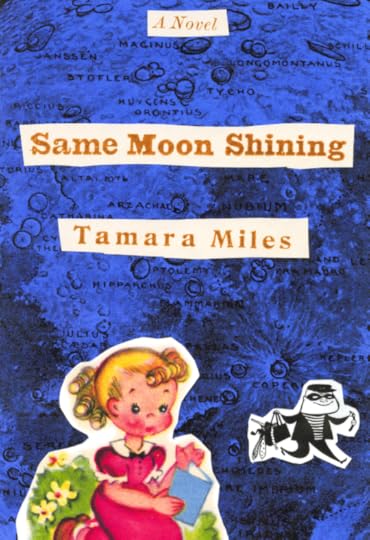
Today’s cover is designed by Tony Pinto based on the Personal novel Same Moon Shining by Tamara Miles.
Same Moon ShiningThis is the story of a father and daughter; estranged then reconciled. They find a mutual understanding and acceptance of their history through a century long tale of abandonment and crime and hard lived lives. Told with compassion and heart for the myriad characters that populate this thoroughly American story this book will appeal to all those interested in who we are and how we got there.
Tamara Miles spent her formative years in public libraries, thanks to a wonderful mother who taught her to read early and thus gave her a life. She has been a contributor in poetry at the Sewanee Writers Conference and a guest at Rivendell Writers Colony, and published a chapbook called Earth Gospel. This is her first NanoWriMo.
Tony Pinto is a designer, educator, and fine artist living in Southern California. He teaches graphic design, art history, and painting at several colleges, and is co-owner of Vim & Vigor Strategic Creative, with his wife and business partner, Adrienne Grace.
November 22, 2020
30 Covers, 30 Days 2020: Day 22
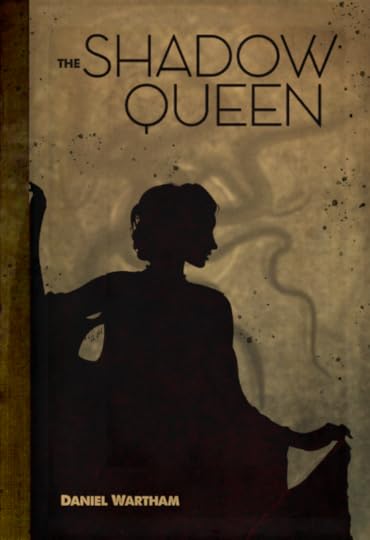
The nights are starting to get longer, so let’s celebrate the Supernatural/Horror genre with this awesome cover designed by Jina Anne based on the novel by Daniel Wartham!
The Shadow QueenSet in 1920’s New York City as a firm backdrop, a lowly newspaper reporter falls in love with a rich and mysterious girl. This woman appears to talk to people made of shadows and darkness and is their monarchical ruler. These figures appear in our protagonist’s dreams and encroach upon him in the real world. The shadow queen needs to use his blood specifically to bring her people forth from the shadows and rule the world, though she’s torn between her responsibility and love, ultimately culminating in our protagonist’s demise.
About The Author
As far as he goes, Daniel is an eighteen-year-old college freshman who is delving into his first long-term writing project. He enjoys Eldritch horror and Westerns and is especially interested in American Literature and growing up in North Carolina, a focus on local history and Appalachian studies.
Jina is a design systems leader and advocate focused. She is a Product Design Manager for the design systems team at Asana. She organizes Clarity, a Design Systems conference. She co-authored the Design Systems Handbook, Fancy Form Design, and The Art & Science of CSS. She has been said to be one of the most cheerful goths. You can follow her on Twitter @jina.
November 21, 2020
30 Covers, 30 Days 2020: Day 21
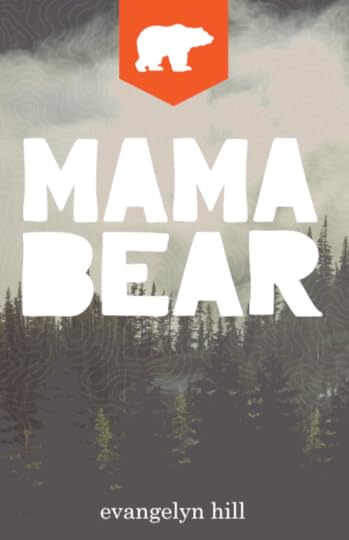
Check out this super cool cover designed by Dane Benton based on Evangelyn Hill’s Children’s Fiction novel Mama Bear!
Mama Bear
Four children and a dog is the perfect number for an adventure, as everyone knows. But what happens to the Lewis children and their father is like nothing they ever expected. When their mother disappears, and the police are strangely reluctant to find her, they take matters into their own hands and follow her trail around the world. Through hardships, adventure, and tragedy, the four children and their father must learn to trust trust each other and realize what being a family really means – before it’s too late.
Evangelyn is a homeschooler who loves tea, horses, and writing for kids. She strives to portray both darkness and light in my stories to uplift (and entertain!) people.
Dane Benton is a midwest-based designer with over a decade of experience leading inhouse design teams in nonprofit organizations. While growing up in rural Missouri, Dane became enthralled by the ability design has to shape perception and opinion, and after turning down a vocal performance scholarship, earned a Bachelor of Arts from Anderson University and has dedicated his career to helping others. When not chasing around his two kiddos or singing in various music productions, Dane enjoys woodworking, hiking, writing, daydreaming about his next trip to Walt Disney World, and spending time with his family.
November 20, 2020
Why Genre Isn’t Just About Content

Every year, we’re lucky to have great sponsors for our nonprofit events. AutoCrit, a 2020 NaNoWriMo sponsor, helps you celebrate your commitment to your novel with excellent editing resources. Today, they’re here to share some insight about how the your novel’s genre can shape your word choice as well as your story:
Anybody could be forgiven for believing that genre is defined by content. A fantasy story is fantasy because it deals with magic, myth, and worlds different from our own. Horror is horror because it seeks to scare us with monsters, ghosts, and the dark side of humanity. Romance is romance because it centers on relationships and the “will they, won’t they” romantic narrative.
But content isn’t the only thing that delivers a true genre experience on the written page – as an author, the success of your story is also deeply rooted in the language you use.
Just like cinema has its own visual language that subtly (or not so subtly) clues us in on the kind of movie we’re watching, genre literature also takes advantage of linguistic seeds to create the kind of reading experience fans enjoy.
But how is it done? Let’s dive in and see!
First to the front-line in backing up your content delivery are what we call Power Words. Well known in marketing circles, these words have an automatic impact on the human mind. This could be down to onomatopoeia, the forceful or strange nature of a word’s pronunciation, or simply the natural imagery a word conjures.
Words such as intense, obliterate, breathtaking, and slyly would all fall under the banner of Power Words.
In fiction, power words are a useful way of condensing concepts and feelings into a single word that elicits a strong emotional response. After all, the more concise and clear your writing is, the better it is for your readers. And as the number of these words increases throughout your novel, the emotional landscape of your book begins to take shape – like some long-forgotten island emerging from a blanket of fog – forming the basis of how your reader feels as they move through your story.
At AutoCrit, we regularly research and inspect the emotional foundations of all kinds of novels. See if you can guess what kind of stories these are:
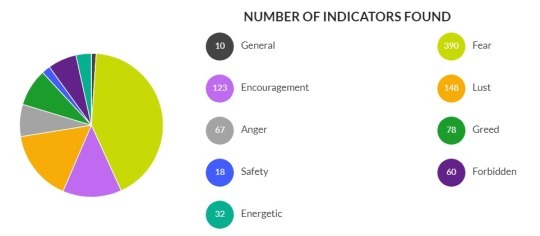
The above is, of course, a horror novel. A heavy blanket of words rooted in fear takes prime position here.
Here’s another:
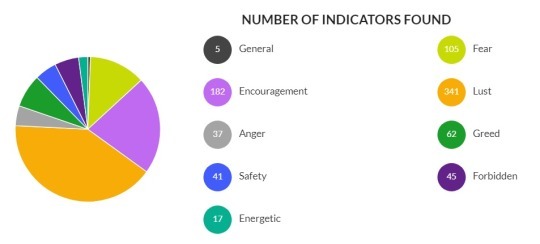
You can probably guess that this particular novel is a romantic drama, with a heavy dose of lust-based language backed up by encouragement (a staple of any involving dramatic arc) and, of course, fear – reflecting the fear of loss, or missing a chance, that so many romantic narratives rely on.
And a final example:
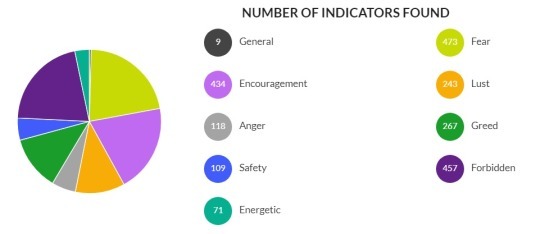
At the forefront here is an almost equal combination of the forbidden, encouragement, and fear – backed up by a large sprinkle of lust and greed.
This is, of course, a mystery thriller – Dan Brown’s The Da Vinci Code, to be exact!
Looking at these charts, it’s almost too easy to place the kind of novel to which you’d expect them to belong, and that’s reflective of the importance of proper power word management. The content could be the same, but a horror novel simply wouldn’t feel like a horror novel if the language were primarily rooted in a safe or encouraging emotional space. Would it?
But hold on just a moment, because we’re about to go deeper…
The truth is that even the most innocuous words are essential building blocks of storytelling, and therefore deserve the same level of scrutiny in your finished work.
The word dragon, for example, is unusual enough that you could instantly know it is more likely to appear throughout a fantasy novel than it would in, say, a modern day spy thriller. The same could be said for the power word kill – much more likely to show up in horror than romance. That’s an easy one.
But what about a word as simple as just?
Usually viewed as a filler word that can easily be deleted during editing, something as simple as just can actually be used to great effect in different genres – that is to say it does have a place.
Take a look at these examples, where we’ve compared our use of the word just in a horror novel to what we would expect, through extensive research, to see in books of other genres.
First up, fantasy:

Compared to the content of an average best-selling fantasy novel, AutoCrit recommends we remove 18 instances of our use of the word just.
The fantasy genre is one that relies most on its world-building and the visceral experience of the narrative, so we’re less likely to see simple, common words being used to subtle effect. That’s not to say such a thing doesn’t exist within fantasy, but it is more likely to happen in romance, which we see here:
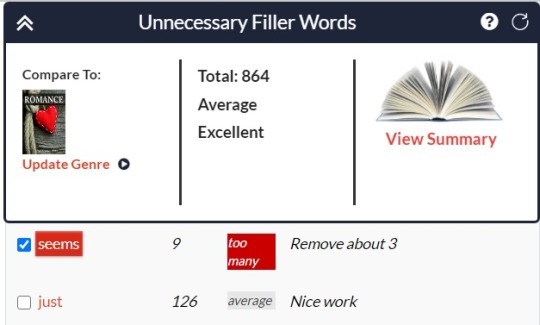
In romance, our use of just appears to be completely within expectations. There is a good reason for this: Romance often deals with human emotion and relationships, sporting increased amounts of dialogue. Naturally, people will use filler as they speak, so words like just are going to be more common here.
But since we’re writing a horror story, what about comparing our manuscript to best-selling horror?
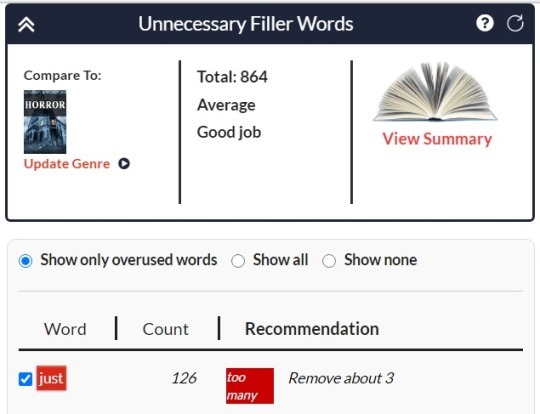
Far fewer than the 18 removals recommended under fantasy, in horror it’s recommended we remove only 3. This is, again, reflective of the difference in base language between the genres – horror can very effectively use the word just to demean characters or increase horrific effect by seemingly playing down the shocking nature of occurrences.
Your story’s content often helps to dictate the language used – but, as you can see, it’s always worth revisiting your use of language while you refine the experience for readers throughout your second draft and beyond. Being aware of the overall context as you edit is a power to be envied by any word wizard.
The right content, delivered with the right words to the right audience. Now there’s a recipe for NaNo success.
Here at AutoCrit, we’re looking forward to helping you achieve just that throughout the remainder of 2020 and beyond. Visit our NaNoWriMo 2020 offer page to enjoy 60% off an annual AutoCrit subscription.
NaNoWriMo winners also enjoy free entry into the January editing of our Book Editing Breakthrough Challenge, where we’ll guide you day by day through the how and why of the most impactful edits you can make in your manuscript.
Happy writing!
Top photo by Shelby Miller on Unsplash
30 Covers, 30 Days 2020: Day 20

So who else is loving this cover?! It was designed by NaNoWriMo’s ver y own Katharine Gripp based on the Supernatural Mystery Novel The Art of Revenge by YWP Participant Caleb Cochrell!
Alec Flynn, an overconfident criminal mastermind, believes that nothing can go wrong. Until one night his best friend and partner in crime, Kyler, is killed in a massive explosion, and Alec finds himself in custody with convincing evidence that he was the murderer. With the help of a rogue FBI agent, he infiltrates a strange correction facility in order to unravel the mystery of a ghost assassin cult. But while searching for answers, he discovers one to a question he didn’t ask- why did anyone want Kyler dead in the first place?
About The Author
Caleb is an original fourteen-year-old author who sincerely hopes this novel goes better than his others. He loves all things music, acting, traveling, and photography. When he needs a break (which is a lot), he’s always up for a hike in the mountains. He likes to read, think deep thoughts, and hang out with his best friends, who are the best. Currently living in the countryside of Massachusetts, Caleb loves God and his big and (sometimes) annoying family, especially his little brother. He wishes everyone out there the best of luck with their writing!
Katharine Gripp has been participating in NaNoWriMo off and on since high school, and finally won for the first time (without cheating) in 2018. She loves getting to share writing advice from authors and participants as part of her job, and tries to pick up as many helpful tips as she can in the process. When not writing, she can be found learning new styles of dance or playing music with her folk-punk band.
November 19, 2020
“Kick out the little voice inside your head that’s trying to...
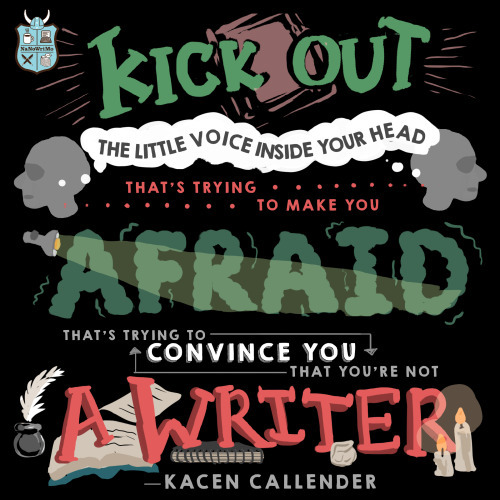
“Kick out the little voice inside your head that’s trying to make you afraid, that’s trying to convince you that you’re not a writer.”
Born and raised in St. Thomas of the US Virgin Islands, Kacen Callender is a bestselling and award-winning author of the middle-grade novels
Hurricane Child
and
King and the Dragonflies
, the young-adult novels
This Is Kind of an Epic Love Story
and
Felix Ever After
, and the adult novel
Queen of the Conquered
and its forthcoming sequel
King of the Rising
. They enjoy playing RPG video games in their free time. Kacen currently resides in Philadelphia, PA.
Read Kacen’s full pep talk here.
Loved Kacen’s pep talk? Let them know!
Image created by Sandra Moore.
30 Covers, 30 Days 2020: Day 19

Check out this awesome Adventure novel by Sydney and the amazing cover art by designer Lauren Vajda!
Two new recruits for the Secret Organization of Spies (S.O.S.) Gabi and Anna are sent on their first mission: to scout out areas on an island for enemy activity. However, trouble arises when they touch a magical object that the enemy is searching for.
Sydney is a young aspiring author that has had a passion for writing since a young age. She was recently published in a short story novel for one of her works. Outside of writing, she loves the outdoors, and has been swimming competitively since about eleven years.
Lauren Vajda is a designer and principal of the San Francisco Bay Area based design office, Verso. She strives for making an impact with non-profit organizations. When she’s not designing, she is likely hiking with her family, hopelessly attempting to become the next Star Baker, or reading a good book (or three).
November 18, 2020
YWP Participant Pep Talk: Writing Is Not Impossible

We could all use a little extra cheerleading during NaNoWriMo—so, we asked some of our Young Writers Program participants to write and share their own pep talks! Today, YWP writer Noelle P is here to give you some extra pep:
So, you’re writing a novel in a month. Maybe you’re cruising ahead with your novel, or maybe you’ve only got a couple of characters, a setting, and hopefully some idea of a story. But no matter how much planning you’ve done, eventually, you’re bound to get that feeling we all dread… nervousness. Yeah, it’s great, right? Don’t you just love the extreme pressure that comes with trying to reach such a big goal?
Well, I’m here to tell you that there’s nothing to be nervous about. It might sound fake, but I’m telling the truth. If you want to write a novel there is NOTHING stopping you from just doing it!
“But what if it’s not good enough?”
Okay, I’m going to dispel a myth that has plagued aspiring writers since the beginning of time. All you need to write a book is:
An ideaThe desire to write it downDo you happen to see ‘talent’ anywhere on that list? Do you see ‘having multiple books published already’ on it? If you do, you should probably check again, cause it’s not there.
Does this mean that your first draft is going to be a New York Times Bestseller? NO! It’s going to be messy, there will most likely be plot holes, and it might not make a lot of sense. But it’s the first draft, you can worry about all that with the second one, the whole idea of a first draft is to get the words down. That’s it.
“But if that’s all it takes to write a novel, why doesn’t everybody do it?”
Ding! Ding! We have a winner! Cause that’s the million-dollar question right there isn’t it? Why doesn’t everybody write a novel? I’m sure you’ve met plenty of people who have wanted to at some point in their lives. So why don’t they?
It’s because we, for some wild reason, have decided that writing is this unreachable goal that only superhumans (cough, cough, famous authors) can reach. Which, in my opinion, is kinda ridiculous. For one, famous authors are no different than you and me, they’re just people who looked at this whole writing thing and thought, “Hey, I could do that!” Second, writing a book is not an unreachable goal, and if you still think that, go re-read this whole thing, cause I obviously didn’t get through to you.
I’ve wanted to be a writer for a long time, but whenever I told people that’s what I wanted to be, I’d receive “the look.” You probably know the one I’m talking about. It’s the one that says, “Yeah honey I’m sure you will, but don’t be disappointed if that doesn’t work out.” I used to wonder why this happened. Did they not think I was good enough? Except that those people weren’t trying to be mean, it had just been ingrained in them that writing was impossible.
I’m going to say this one more time: Writing. Is. Not. Impossible. Just imagine how many more worlds, characters, and stories we’d get to explore if more people realized that. Oh wait, you have the chance to realize that right now. Have you? Good, cause I really want to hear your story.
Just to be clear, I’m not saying that writing isn’t hard. There will most likely be tears, frustration, and you’ll probably wonder why you ever thought this was such a good idea anyway. Writing a novel takes work, and if you’re not willing to work for it, you might have a harder path ahead of you.
Okay, so we’ve learned that writing isn’t as impossible as people think. We’ve decided that authors are just as human as we are and that we shouldn’t let “the look” discourage us. We’ve trudged through the difficulty of writing a book and have chosen to ignore it for the possibilities. So now it’s time for me to stop talking, it’s your turn now, pick up the pen, put your hand on the keys, and write.
Noelle P. is a thirteen-year-old who enjoys guitar, listening to music, musical theater, deep conversations, and movies. She mainly reads Dystopian and Contemporary Fiction but will read anything as long as it has good characters. This is her first NaNoWriMo, but she hopes to do many more.
Top photo Courtesy of Alysha Rosly via Unsplash.
30 Covers, 30 Days 2020: Day 18
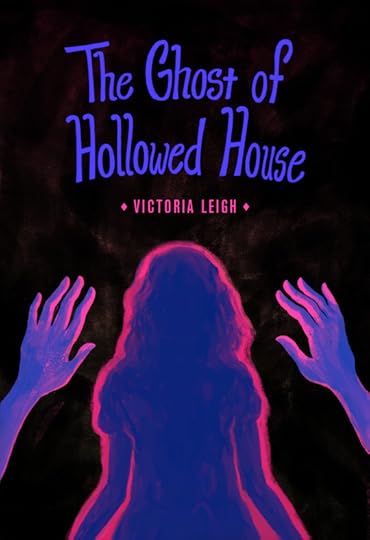
Today’s novel is a Horror/Supernatural novel written by Victoria Leigh with the cover designed by Kim Weiner!
The Ghost of Hollowed House
Hugh Fowley, a local historian, was hired to write the biography of Mayweather Hallow, the matriarch of a prominent local family. That is, until he is murdered at the funeral reception of Mayweather herself. Someone wants to bury the all of the family secrets with Mayweather and her biographer.
Private Detective Graham Rhys is hired by the family to prove the innocence of the most likely suspect, Mayweather’s eccentric great-granddaughter Evangeline Hallow. A no-nonsense kind of guy, he writes off Evie’s beliefs in the supernatural. She insists that a ghost murdered her great-grandmother. But as he explores the mysterious town of Knollsville and uncovers the secrets of the Hallow family, he begins to believe that Evie isn’t as crazy as everyone believes.
Just like the setting in her novel, this NaNo Participant has chosen to continue to be a mystery!
About The Designer
Kim is a motion focused animator, illustrator, and art director living in NYC. She received her BFA in Animation from the Rhode Island School of Design and Masters in Branding from the School of Visual Arts. Her work captures her range of passions across the fields of 2d animation, technology, and storytelling.
November 17, 2020
Pro Tips from a NaNo Coach: How to Finish Your First Draft
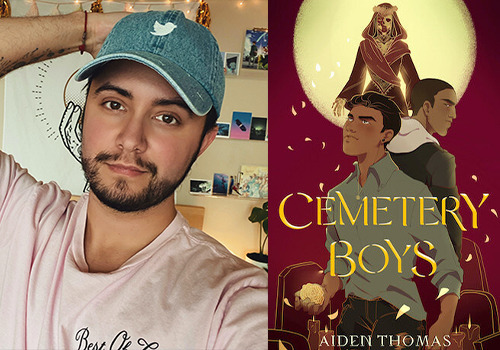
NaNoWriMo can seem like a daunting task sometimes, for NaNo newbies and veterans alike. Fortunately, our NaNo Coaches are here to help guide you through November! Today, author Aiden Thomas is here to share some advice on pushing through to the end of November:
Hello Friends! My name is Aiden Thomas, I am the New York Times bestselling author of Cemetery Boys and I’m your Nano Coach for the dreaded week 3 of National Novel Writing Month!
I think most authors would agree that they hit a wall around the 30K mark of their manuscript. You’ve ridden out the high and novelty of Week 1; Week 2 things started to get tricky as you got deeper into your plot; and now you’re on Week 3. Right about now, your stakes are high, your character is facing some challenges, and very likely so are you. At this point it’s easy to get stuck, so I wanted to give you some advice on how to keep pushing forward.
The first and most important thing to realize is that your rough draft will never live up to your vision—and it’s not supposed to! First drafts are supposed to be crappy. The story you have in your head will never be exactly as you want it on the page the first time, and especially not in 30 days! Right now, you just need to get the words down. Stories become beautiful books with revisions, not during a fast draft!
So, how do you keep pushing forward and get that crappy rough draft done so you can hit your NaNoWriMo goal and start revising? I’ve got some tips!
1. Talk it OutThe most helpful resource to me as an author are my writing friends and critique partners! When I get stuck, I usually send them a Google Doc with the challenges I’m facing and we talk them through and come up with solutions. About half the time, I don’t even take their advice, but just bouncing ideas around helps me come up with an answer! Sometimes getting out of your own head and just talking it out with someone—even someone who isn’t a writer!—can give you the inspiration you need to break through writer’s block.
2. Bullet PointsOkay, this is lowkey Plotter propaganda, BUT JUST BEAR WITH ME! I often get stuck with the crushing stress of hitting my writing goal to the point where I freeze up, unable to move forward. Looking at the larger plot can be totally overwhelming, so try focusing smaller accomplishments that feel more manageable. By taking it one scene at a time and really breaking down the sequence of events, you’re setting yourself up for success by hitting achievable goals!
3. Take NotePlot holes are a total pain and can pop up out of nowhere! When you figure out there’s a problem with your plot, or maybe just a detail you realized needs to be changed 20,000 words earlier, don’t get distracted! When that happens, take note of it (either leaving a comment within the manuscript or writing a list) and fix it during the next draft. You probably want to fix it immediately, but now is not the time! This is a crappy first draft, remember? And you’re on a deadline!
4. Focus TimeWriting sprints are a whole thing in the NaNoWriMo community, but I find them intimidating! The pressure to write a bunch of words quickly in a set amount of time sometimes just makes me freeze up completely and I get nothing written! A lot of folks don’t work well under that kind of stress, especially if you’re “competing” with friends to get the highest word count. What I find MUCH more helpful are doing “focuses”. I’ll pick an amount of time (usually 30 minutes) and commit to doing nothing but writing for those 30 minutes, no distractions! It takes some of the pressure off and it’s a lot easier to reason with myself to get writing done if it’s “just for 30 minutes.” After the focus time, I can get a snack or mess around on Twitter, but for those 30 minutes I am entirely invested in writing!
The most important thing to remember is that by November 30th—regardless of if you hit 50K or not—you will have gotten more of your story written than you did November 1st, and that’s still a success! Take a deep breath, try not to put too much pressure on yourself, and keep moving forward.
Aiden Thomas is a New York Times Bestselling author with an MFA in Creative Writing. Originally from Oakland, California, they now make their home in Portland, Oregon. As a queer, trans, Latinx, Aiden advocates strongly for diverse representation in all media. Aiden’s special talents include: quoting The Office, finishing sentences with “is my FAVORITE”, and killing spiders. Aiden is notorious for not being able to guess the endings of books and movies, and organizes their bookshelves by color.
Chris Baty's Blog
- Chris Baty's profile
- 63 followers



